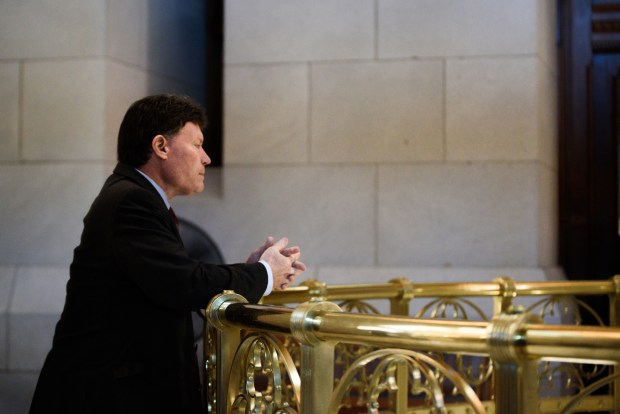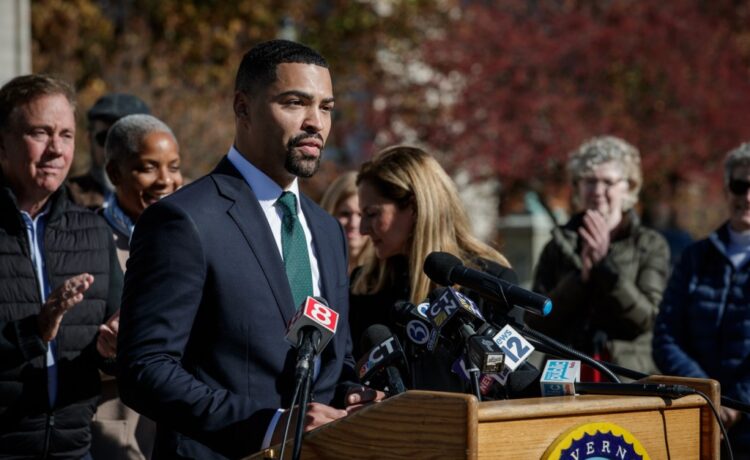As Wall Street continues to break records, the state pension fund’s performance has reached its highest level in history at $55 billion.
For the 2023 calendar year, the pension funds increased by 12.8%, pushing Connecticut up in the national rankings.
The strong performance marks a solid turnaround from years when Connecticut ranked as the second worst pension fund in the nation, according to a study by the Yale School of Management. The annualized return for the five-year period from 2017 through 2022 was 5.8%, which was less than half of the highest performing state, Washington. Connecticut ranked ahead of only South Carolina in the survey.
The study prompted the legislature’s tax-writing finance committee to hold a forum last week with the state treasurer, who oversees the investments, and top Yale officials regarding the state’s past and current performance.
Legislators blasted the funds for the previous poor showing, including being the nation’s only public pension fund to lose money in 2012. Part of the problem was massive turnover in the office during a 12-year period, including 10 different chief investment officers — a crucial position in managing the funds.
Professor Jeffrey A. Sonnenfeld, a highly regarded academic who serves as senior associate dean at the Yale School of Management, conducted the analysis of all 50 states and said that Connecticut has recently turned the corner under Erick Russell, who started in January 2023.
“Treasurer Russell has done a superb job, as a first-year public official parachuting in,” Sonnenfeld told lawmakers. “It is breathtaking. … We’ve come a very long way. We wouldn’t say mission accomplished just yet, but I wouldn’t have anticipated we would be where we are.”
Sonnenfeld added, “The pension funds are clearly moving in the right direction. … There’s still more that needs to be done, though.”

Large turnover
In the past, there was huge turnover in key positions that became a revolving door. The most important was the chief investment officer, where the occupant has averaged less than two years since the position was created nearly 25 years ago.
The most extreme case came in 2018 under then-Treasurer Denise Nappier when the new chief investment officer, Sean Crawford, quit after only 10 days. Crawford had been hailed before his hiring as a top investment manager for the previous 21 years on Wall Street who was well prepared for the position that paid $325,000 per year.
Nappier said only that it was “an unfortunate situation,” and she wished Crawford “the very best in his future plans.”
A replacement was hired but eventually left the treasurer’s office less than three years later.
Both Republican and Democratic legislators admitted they had failed to provide the proper oversight of the treasurer’s office during the years of poor performance that included the 20-year tenure of Nappier, a Hartford Democrat who won five statewide elections as a constitutional officer with an independent office.
After discussing the poor performance, state Sen. John Fonfara of Hartford conceded that the legislature and the Investment Advisory Council, which oversees the investments, have not watched the treasurer’s office closely enough in the past.
“We’ve got some catching up to do,” Fonfara said to Russell. “It does not mean we are attempting to manage your office.”
Fonfara said he admits to failing to ask enough questions in the past.
“We have not met that charge historically here,” he said. “We don’t have a Program Review and Investigations Committee here any longer.”
“Where was the Investment Advisory Council during that time? These folks who are the watchdogs,” Fonfara said, adding that a baseball manager’s performance is often not assessed until a new manager is hired.
Russell responded that the I.A.C. meetings are held six times per year and are open to the public.
“Historically, I can’t speak to everything that happened prior to me being here,” Russell said, adding that changes have been made and a new asset allocation of investments is now in place.
Rep. Holly Cheeseman, the committee’s ranking House Republican, agreed the pension fund has been troubled.
“In 2012, Connecticut was the only pension fund in the country actually to lose money,” Cheeseman told Russell. “Where was the I.A.C. on that? … But that’s in the past.”
The back-and-forth continued as the finance committee heard testimony for more than three hours about the pension funds’ past weaknesses and current performances.
“This matters because it ends up impacting residents,” said Sen. Tony Hwang, a Fairfield Republican.

Monica Jorge / Hartford Courant
State Sen. John Fonfara, a Hartford Democrat, says there was a lack of oversight over the state treasurer’s office in the past. Here, he stands outside the state Senate chamber on the third floor at the state Capitol in 2017.
Funding surge
A major development in recent years has been surging state budget surpluses, which has allowed the governor and legislature to allocate an additional $7.7 billion to the long-underfunded pension funds.
Now, the state employees pension is funded at 52%, while the teachers are at nearly 60%. The municipal employees was at 74% as of June 2022. Some of those numbers had been in the low-30% range before the surge in funding and the decision to pour the actuarily required amounts into the fund annually after often neglecting the full funding for decades.
One of the problems with the treasurer’s office, officials said, is that the office’s true performance could be obscured through a blizzard of financial statistics and comparisons to various benchmarks that could make the performance appear better than it actually was. Without closer scrutiny, the performance could be misunderstood and weaknesses missed. Lawmakers conceded there was relatively little oversight at times in the past.
Some of the statistics also include the rankings. Russell said that Connecticut’s improvement has pushed it into the top 27%, but Sonnenfeld noted that the comparison includes 85 local and state pension funds that are above $1 billion, including 70% as municipal funds, not from states only.
Series of funds
While officials often make reference to the pension fund, there are actually six different pension funds and 12 trusts that cover about 300,000 state and municipal employees, teachers, retirees, and survivors. State employees, teachers, and judges, for example, all have separate pension funds.
“We are long-term investors,” Russell told lawmakers. “Our goal is to have sustained returns over market cycles. … We are certainly proud of our one-year numbers. … We were able to move up the ranks with our performance.”
“We’ve been working to right-size the portfolio,” Russell said. “Global equities and fixed income are coming down.”
Since June 2023, the fund’s targeted goals have shifted to reduce stocks and bonds, while increasing in real estate and private equity, among others.
Russell received bipartisan support from the committee members.
“Basically, you have a good story to tell,” said Rep. Maria Horn, a Litchfield County Democrat who co-chairs the committee. “The good things that are happening are durable.”
“We want to see you succeed, no matter what side of the aisle we are on,” said Sen. Ryan Fazio, a Greenwich Republican.
The pension fund is so large that a 1% change amounts to $550 million, and a change of 2% represents $1.1 billion.
Connecticut is one of only two states, along with North Carolina, that allows the state treasurer to be the sole fiduciary over the pension funds, meaning that he can make all the final investment decisions and does not have a special board that makes the decisions.
Yale recommendations
Among other recommendations, Yale officials said when they issued the report last year that Connecticut should hire only the top money managers and should drop the worst ones. That would normally be an obvious conclusion, but officials said that was not always the case through the decades.
Another issue is that the treasurer’s office currently pays more than $100 million per year in fees to outside managers to manage investments, and the state should use its leverage to reduce those fees, Yale officials said.
They also called for changing the asset allocation, meaning that the treasurer should buy more American stocks and reduce exposure overseas. In addition, Yale said the state should switch more money into low-cost index funds, such as one that would mirror the performance of the S&P 500.
“Changing asset allocation towards a more normalized mix of assets, reversing mistaken decisions such as the underweight U.S. equities and the tragically overweight emerging markets, until quite recently in Chinese equities, hurt this state badly,” Sonnenfeld told lawmakers. “But we’re getting out of it, so good for them. … There’s still more that needs to be done, though.”
Over five years the pension funds ranked only in the top 56%, while over 10 years, it was in the top 40%, according to the statistics.
“Connecticut has had some of the worst pension performance of any state,” Sonnenfeld said. “The investment performance was chronically one of the worst in the nation.”
State Rep. Eleni Kavros-DeGraw, an Avon Democrat, asked if Connecticut is investing in gun manufacturing and fossil fuels. Russell responded that, in one instance, the leverage from the state led to environmental improvements from a company where the state had investments.
“We have not made a net-zero pledge in Connecticut,” Russell said. “Our approach is engagement. We’ve been really successful in that engagement. … We got them to commit to closing all of those coal plants.”
Yale researcher Steven Tian, who works with Sonnenfeld, said the pension funds could have been much larger if they had been managed properly. With low fees, a traditional index fund, which is routinely used by individual investors, often outperformed the state’s well-paid managers.
“Connecticut missed the bull run in stocks,” Tian told legislators. “We just totally missed it. … Connecticut would have had many billions of dollars more. … Connecticut had the habit of doubling down on a bad bet. … That’s the irony that the public employees and teachers would have done better on their own.”
Christopher Keating can be reached at [email protected]















